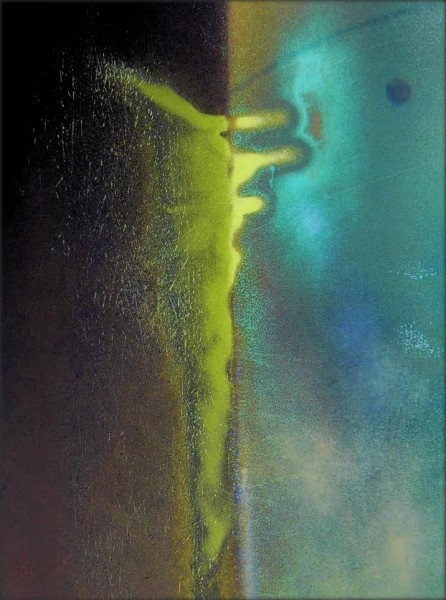His wife recognized him in a photograph during a special exhibition at the National Gallery. It was a photograph he had already passed over with the same moderate attention he brought to all but the most engaging pictures—car accidents, say, or shadow stains on concrete after a nuclear blast. A few people murmured and pointed at the white-bordered squares, offering snippets of criticism and observations, their wrists twisting as they spoke, their thumbs flopping in half-hearted emphasis.
“Nemanja,” his wife called, striking through the rubbish of background noise. He turned and raised his eyebrows. She waved him over, and he wove around those staring hard at the photos, trying not to sever their lines of sight. He arrived beside his wife. “My God,” she said. “It’s you.” She pointed at a figure on the left side of the frame, not indistinct at all, but crisp, well defined. He stared at the figure and felt a ghost pass through him, a fleeting cold. The man was him. Not as he was when these photographs had been taken, twenty years ago, but as he was now. The camera angle emphasized the bald spot on the crown of his head, visible as a flattening in his dark hair whenever he looked in the mirror. The creases on either side of the mouth were the same. The protruding mollusks of his ears. The build and height looked right, too. Despite the impossibility of the picture actually depicting him, he felt the uncanny sensation of looking at himself shrunken onto a 12″X12″ photograph hung on a museum wall. Not only would he have been a much younger man when the photograph was taken, but he had never been near the site of any of the photographs in the exhibition. They were by a group of artists who secretly catalogued the Bosnian war and the ethnic Serbian genocide under Mladić. This picture was one of the least graphic in the exhibit, no dead soldiers, no walking wounded. His doppelganger stood in front of a crumbled brick wall that looked like part of an apartment building. The figure held a Kalashnikov by the barrel stock. “It’s so like you,” his wife said. “To see your face beside those poor children.”
He turned to her. “What children? There are no children.”
“Three of them,” his wife said, slowly raising her finger to point at a pile of rubble in the center of the picture like a broken altar.
“There are no children,” he said. She looked from him to the picture. Her voice was very small.
“There are three. Two boys and a girl. Laid next to each other, with bullet holes in their chests and their shirts ruined.”
He stared at the picture, but saw nothing other than rubble and his doppelganger. His wife tapped the shoulder of a woman looking at the next photograph in line. “What’s the subject of this picture?”
The woman looked for a moment at the picture. “The dead children,” she said. “The destruction of hope.”
“I don’t see it,” he said.
When he spoke the woman looked at him and her eyes widened. “It’s you.”
He rocked back a step and waved his hands. “Of course it’s not me. That was twenty years ago.”
His wife said, “He doesn’t see the children.” The woman glanced from him to the picture several times and grew very quiet. She seemed to sink away, to fall inward.
Nemanja and his wife progressed through the exhibit, and in photograph after photograph his doppelganger appeared, resonating almost like a theme through the collection. Viewers began to collect around him to see how close the resemblance was. In every instance they were astounded, and he had to agree, the likeness was exact. People asked him what it had been like to be there, to see the things the photographs depicted.
He shrugged and shook his head. “I don’t know. It was not me. I did not see these things.”
He listened carefully as people discussed the photographs. In every picture his doppelganger appeared, there was something missing for him, some part of the picture he could not see. Listening, he pieced together what his eyes would not reveal to him: a bullet-riddled dog on a city street, a man missing an arm slumped against a wall, white lime powder spread over bodies in a trench.
Around him the chatter grew and grew until the quiet atmosphere of the museum was replaced by an almost party feeling, with him at the center. Strangers introduced themselves and struck up conversations. They discussed the photographs’ lighting and composition, the juxtaposition of color and form. Always they asked him about that time. “I was here,” he told them. “I lived in Indianapolis.”
The knot of people passed through the exhibit in a chatting, happy group. Telephone numbers were exchanged. Nemanja passed with them. He could not escape them if he wanted to, and at each new photograph he pretended to see bodies where there were none. Open graves in unscarred fields.



 The core workshop of SmokeLong Fitness is all in writing, so you can take part from anywhere at anytime. We are excited about creating a supportive, consistent and structured environment for flash writers to work on their craft in a community. We are thrilled and proud to say that our workshop participants have won, placed, or been listed in every major flash competition. Community works.
The core workshop of SmokeLong Fitness is all in writing, so you can take part from anywhere at anytime. We are excited about creating a supportive, consistent and structured environment for flash writers to work on their craft in a community. We are thrilled and proud to say that our workshop participants have won, placed, or been listed in every major flash competition. Community works.